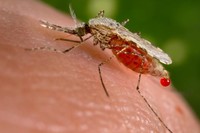Gelsen species and life forms
Approximately 53 species of mosquitoes from 7 different genera have been recorded in Austria. They differ not only in their appearance and genetics, but also inhabit different habitats, prefer different breeding waters and also differ in their behaviour, e.g. in their host preferences: In some species, the females prefer to sting mammals, while in others they prefer birds or amphibians. Despite these differences, it is possible to categorise the gnats that occur in our country into a few life form types. Knowledge of these life form types is essential precisely because it makes it easier to understand the respective behaviours. This makes it easier to find your own strategies on how best to protect yourself from them and possibly also how to prevent them from reproducing uncontrollably.
Flood gels
The group of so-called flood geckos (members of the genus Aedes, e.g. Aedes vexans, Aedes sticticus) mainly lay their eggs in dry terrain in floodplains, where the clutches can then wait a long time - even several years - for water. After a flooding event, there is then an explosive and mass development of these geysers. These gnats do not migrate far from the breeding sites under their own power, but they can be passively drifted by strong winds and thus also reach distant settlements, where they are then a short-term nuisance not only at dusk but also during the day. However, flood geldings only very rarely enter buildings. As flying adults, they only live for a relatively short time and only the robust egg clutches overwinter.
House-Gelsen
However, the biology of the so-called house jellies (representatives of the genera Culex and Culiseta, e.g. Culex pipiens, Culex torrentium, Culiseta annulata) is completely different: In the wild, the females survive the winter in hollow trees and holes in the ground; in urban areas, they enter houses to hibernate in cellars or frost-free rooms. They also disturb the hibernation in late summer and autumn. In the following spring, the hibernating female mosquitoes seek out small pools of water near their hibernation site to lay their eggs. They use rain barrels, water-filled old tyres, bird baths etc., but also the banks of ponds and stagnant ditches as breeding waters. A female lays around 150-250 eggs as a packet on the surface of the water, from which - depending on the climatic conditions - several generations can develop each year. House jellies are the most common species in urban areas and also invade houses. However, they can easily be reduced by avoiding possible breeding grounds, e.g. by covering rain barrels, regularly renewing water in bird baths, preventing water from collecting in flowerpot saucers, tubs, toys or tools or emptying them regularly. This is also important as members of the house mosquito family (especially Culex pipiens) can also transmit the West Nile virus.
Fever gels or malaria mosquitoes

The nocturnal "fever mosquitoes" or "malaria mosquitoes" (genus Anopheles) are relatively similar to house mosquitoes. Although they are also found in human buildings, they tend to favour damp rooms and animal stables, which they can use not only for hibernation but also as a resting place during the day in the summer months. The females of this species favour large mammals such as cattle as hosts, but they also sting humans. They owe their name to the fact that fever jellies - even in our latitudes - can transmit blood plasmodia (malaria pathogens). To do this, a fever jellyfish must ingest the relevant stages of the pathogens via the blood of a person already suffering from malaria. If the pathogen cycle in this mosquito can fully develop during a longer period of warm weather and it then bites a human again, a malaria infection is theoretically possible in this country too (although very unlikely). The Anopheles species lay their eggs on the surface of the water, preferably in clean and vegetation-rich natural bodies of water. They can also overwinter as egg or larval stages and occasionally form large populations in the open; often as a delayed second "plague wave" behind the flood gels after flooding events.
Tree hollow breeders
Tree hollow breeders (mainly members of the genus Aedes, e.g. Aedes geniculatus) lay their eggs at the edge of tree hollows or other small amounts of water. The eggs can survive here for a long time - even several months. If the water level rises, e.g. after rain, and the eggs are flooded, they hatch. In the urban environment, culturally successive representatives of this group find many other possible breeding waters - from the rain barrel to the flower pot saucer - and are therefore also called "container breeders".
Non-residents-Gelsen
Over the last few decades, there has also been an increase in the presence of alien gnats in Central Europe. These are container-breeding gnat species that originally come from southern tropical regions or from East Asia and were mostly introduced to Europe by freight transport. Under suitable climatic conditions, these species can colonise and spread further. Alien species that demonstrably lead to changes in the structure and composition of ecosystems and have a detrimental effect on ecosystem services, the human economy and well-being are also known as "invasive species". In Austria, the Japanese bush mosquito (Aedes japonicus), the Asian tiger mosquito (Aedes albopictus) and the Korean bush mosquito (Aedes koreicus) have been detected to date. As the Asian tiger mosquito in particular could also transmit exotic pathogens (e.g. chikungunya, dengue, Zika), it is important to report the presence of this species (via the "Mosquito Alert" app).
Last updated: 04.08.2025
automatically translated